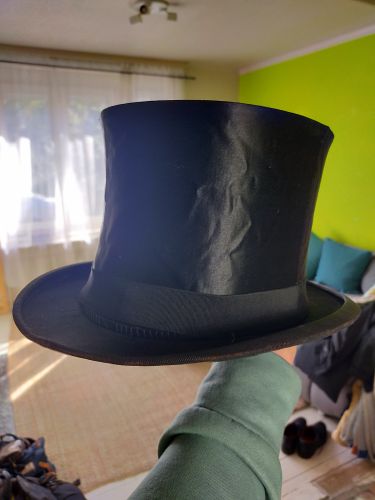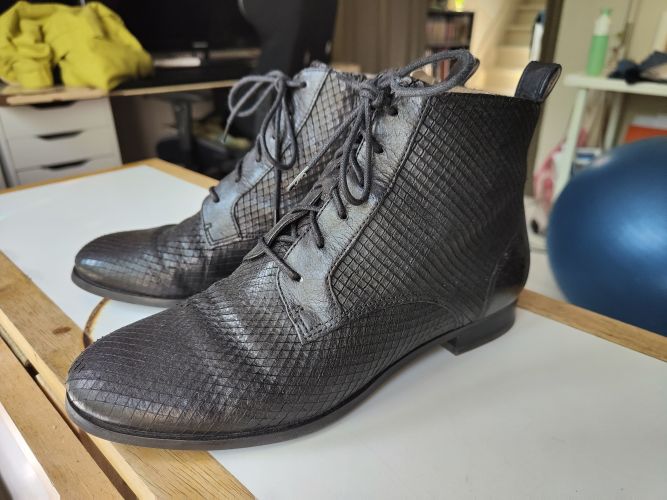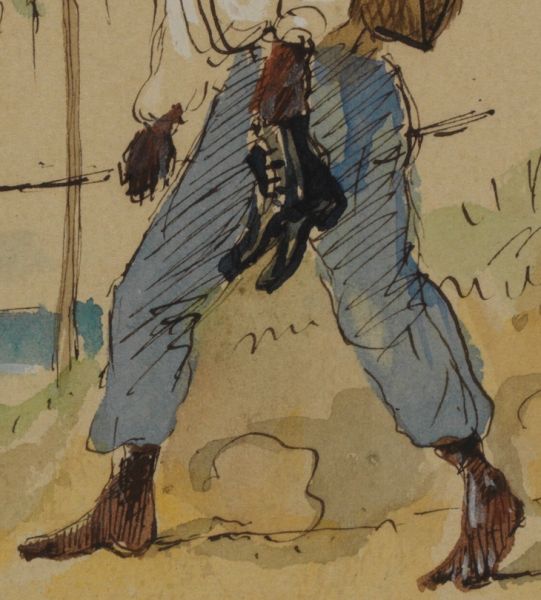Reconstitution of the Citizen's costume
1rst part : the research
The citizen
Let us return to this watercolour by Hippolyte Charles Napoléon Mortier, the Duke of Trevise, of which we have already given a detailed description in the article A citizen of 1848, which we urge you to read before continuing with this article.

Opposite, the watercolour by Mortier de Trévise depicts a man whose clothing is a certain "paradox" (as described in the article A citizen of 1848)
His self-confident attitude, combined with his pride in his title of citizen, making our character a man finally free since the abolition of 1848, made us want to carry out the necessary research in order to reconstitute his outfit for our first historical reconstruction.
We will see together the necessity to do a lot of research beforehand to proceed with the reconstitution of a historical costume.
Of course, our team would be absolutely delighted to discuss and exchange ideas either by email via the Contact Us page or via the Facebook page. We hope to hear from you soon!
The Clothes
The man's outfit consists of two visible items of clothing:
- a shirt
- a pair of trousers
The pair of trousers
Let's take a closer look at the pair of trousers this man is wearing
Although the watercolour does not allow us to define what type of fabric was used for this garment, our research points to cotton canvas from Pondicherry.
Our article One Mystery solved deals with this trade, the importance of which seems impossible at the time, and yet!
The colour is characteristic of the clothes worn by the workers of Le Coat de Kerveguen (a large landowner in the south of Reunion Island) because twice a year he gave them 8 m of indigo-dyed cloth to wear.

Above, a medley of different watercolours by HASTREL Etienne Adolphe Martial, DUMAS Jean-Baptiste Louis of workers in their blue cloth costumes.
We will have the opportunity to deepen the subject in the course of our reconstructions, as this blue fabric appears on many other historical documents, and concerns the people we wish to highlight in this project.
These trousers seem to me very simple and comfortable.
Simple, because the people receiving the fabrics were certainly not great seamstresses (except for specialized people within the community). It must have been easy to create, and easy to recreate because due to the daily physical work, these clothes deteriorated rapidly. We don't have any more of them nowadays, certainly because of this rapid deterioration...
I use the word "comfortable" because the amplitude of the trousers at the level of the thighs and the calves suggests an easier circulation of the air and especially an ease of movement, useful for his condition of worker.
I will thus leave on a reconstitution based on a simple straight cut trousers.
All clothing in the 19th century covered the body, even at the ankles, both for men and women.

Above are examples of photographs of EYCKERMANS Albert Jean Leopold, kindly shared by his descendant EYCKERMANS Peter, and an engraving by ROUSSIN Louis Antoine
Here we can see that the fabric stops above the ankle: why? Well, we suppose that it allowed the bottom of the trousers to be less dirty, or even less damaged.
There were techniques for placing strips of fabric at the lowest hem of the garment which, once placed, protected the main fabric, and which, once too damaged, were changed. However, this meant taking the time to do it, and having enough fabric to change.
One could also imagine other reasons such as: to be less hot, or because there was not enough length to the fabric to go up to the ankle, but you will see in the course of our reconstructions that most of the workers have this same detail.
The watercolour unfortunately does not show much detail about the size.
Given the cost of buttons, or hooks at that time, but also knowing the late creation of effective zips and the elastic band (both dating from the late 19th century), the simplest and cheapest way was to slip a cord or piece of cloth into a gimp at the waist.
This type of closure still exists on some trousers, allowing the wearer to adjust the width at the waist. Quite practical if you have eaten a good curry for example!

I will therefore start with a cord system tied at the waist to make the trousers fit our mannequin.
In order to be able to move our legs more easily, without tearing the fabric or being constrained in our movements, there is an important curve to apply to the front and back of the trousers (marked in yellow in the diagram below, taken from the Lladybird website): the crotch.

The crotch is what you see when you look down the trousers, where the seams cross at the crotch.
This crotch is completely invisible in our illustration because the Citizen has his shoes positioned right in front of him: we can't tell if the crotch is very wide or close to the body.
I will opt for a basic crotch with a wide crotch, as it matches the loose style of the rest of the trousers.
The watercolour may show a shadow on the hips of our Citizen, but unfortunately I cannot see the opening of a pocket...
Moreover, creating a pocket was expensive in terms of fabric: one could use scraps of fabric but this of course required more work.
The addition of a pocket can also weaken the outer seam of the trousers, and to avoid this it is necessary to solidify the seams most subject to deformation, which requires... more thread! And work...

This pocket detail above is a good example of the possibilities of stitches to solidify pocket corners. Indeed, often subjected to friction, the corners of the pockets will be the first parts to get damaged. The Japanese naval costume from which the photo is taken dates from the second half of the 20th century, seen during Visit to the Royal Museum of the Army and Military History (but not documented because it was too late for our project).
The shirt
If the trousers allow us to make assumptions, the shirt does not allow us to make mistakes.
There are two possibilities of origin of this shirt:
- either he bought it, because Le Coat de Kerveguen had his own shop in Saint-Pierre, where he sold many fabrics and cloths. Additional shops were set up near the factories, partly supplied with products sold by Kerveguen himself (there is no such thing as small profits!), and run by Indians or Chinese.
- or he obtained it from his employer so that our Citizen would be well dressed to work for him for example.
In any case, I suggest that we look in detail at this shirt and the existing trends of the time before the illustration (dating I recall from 1865)
At the time, different fabrics such as cotton, silk, linen, etc. were used.
However, given the popularity of starched shirts, cotton was favoured because it could withstand this repetitive treatment better, unlike linen or even the more delicate silk. Silk was preferred for ties, for example, or jacket linings.
I will favour cotton for this shirt, because it was the most common material used in the making of shirts, and more particularly of cotton baptist, which is fine, light and still used in the making of our modern shirts.
Another mystery...
On the watercolour you can see a (more or less) parallel line running from the neck to the waist.
BUT...if I believe the documents concerning the shirts of the 19th century, the buttonholes stopped at the level of the chest so that the buttons did not interfere when the jacket was closed. The illustration below from 1834 shows this feature well with the wearing of the jacket and their different openings.

Credits : The New York Public Library Digital Collections

See how the buttonhole stops at the chest on this document from 1882
The patent for the shirt buttoned from the collar to the bottom of the garment was taken out in 1871 by Brown, Davis & Co! Our illustration of the citizen dates from 1865, and the shirt given away is certainly from an earlier fashion.
I am puzzled by this pencil line, and despite all the research, I have not been able to find a buttonhole that goes all the way to the bottom of the shirt on a garment such as this.
The various "reenactors" patterns such as the one that will be used have buttonholes that stop at the chest, so that is what will be done on the reenactment of this outfit.
The illustration shows a collar as we know it today.
If the fashion was for very straight collars during the reign of Napoleon III, this style ended up changing at the beginning of the 19th century, in particular thanks to the creation of the Maison Charvet in 1838 (Louise Charvet was Napoleon's linen maid from 1813, everything is linked!)

This illustration (by an unknown author, published in Le Follet, Paris, in November 1839) shows men wearing Charvet shirts, one of which has a "turned down" collar (circled in blue) similar to those we see today. It was the desire for change and new fashions once the rule of Napoleon III was over, that drove brands to create new styles.
Our citizen seems to be wearing a similar collar, but not starched, which would explain the somewhat "rough" shape compared to the straight, perfectly starched and well-defined collars of the bourgeois class who can pay a linen maid to starve the collars and cuffs.
He could also have removed the collar, because since 1827 a patent has been registered in the United States so that linen maids/wives can wash the collar without having to wash the whole shirt. The collars and cuffs are therefore designed to be easily removed and starched. Maybe his shirt doesn't have this style of system...impossible to know...
The shirt will therefore be openwork with a "drooping" collar but not starched, as the watercolour suggests
Shirts were indeed looser as they were used as underwear.
But in the 19th century, documents attest to a change, notably with the creation of the Maison Charvet (mentioned in the section on the collar): shirts were clothes seen by others, and to match the popular silhouette of the time, they had to be closer to the body.
The demand for "made-to-measure" shirts is more important, and tailoring techniques and "patterns" with curves are developed to arrive at what we know today.
The citizen wears his shirt without any further adornment, and this one seems to be particularly loose. It is likely that the person who wore it and gave it up to him was heavier or taller.
The shirt will therefore be cut larger than the mannequin to reproduce this detail.
The accessories
If the shirt and trousers required research because they have to be traced, cut, sewn and worn, the accessories already exist and "simply" need to be found.
Let's quickly list here what will be mobilized for the future shooting with our kind model.

The hat
Found second hand, this top hat "slams" back into place with an ingenious mechanism. The shine of the fabric reminded us of the one visible on the citizen's hat

The shoes
Also bought second hand, they are in black leather and despite an additional originality (the diamond texture style on the body of the shoe) compared to the image, they were very much in keeping with the style of shoes held by the Citizen.

The "Bertel"
A Bertel is a backpack woven from Vacoa leaves as explained in the article A citizen of 1848. If this one is smaller than the one in the illustration, it is not easy to find larger ones (new or second hand) as their use seems to be gradually disappearing.
Soon
So what will happen in the next few days or even the next week?
A second article will be written about the making of the trousers and shirt, with further explanations.
A third article will be posted with the results of the clothes created and the accessories put together, worn by a model and graciously photographed by our partner, Studio Non Peut-être.
We hope you are as excited about this reconstruction as we are! We would be delighted to talk about it with our audience.
Feel free to discuss it on our Facebook page or by sending us your remarks, suggestions, corrections, additional information, etc. via our Contact Us page
Credits - curtesy of : ©Iconothèque Historique de l'Océan Indien IHOI (Unless otherwise stated)







